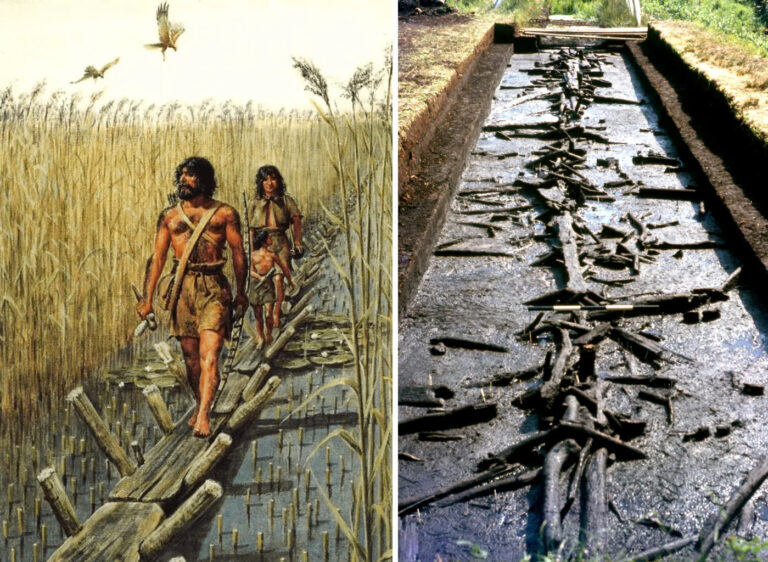Hidden deep within the Somerset Levels in England lies an extraordinary archaeological marvel that continues to intrigue both scholars and history lovers. The Sweet Track, a Neolithic timber walkway estimated to be 5,830 years old, stands as a symbol of human resilience, creativity, and engineering excellence during prehistoric times. Its discovery opened a window into the distant past and continues to offer valuable insight into the life and landscape of ancient Britain. Far from being a mere wooden path, this ancient trackway is a testament to the ingenuity and determination of our early ancestors—an echo of their way of life, skill, and relationship with nature.

The remarkable story of the Sweet Track began in 1970, during what was intended to be a routine peat extraction operation in the Somerset Levels. John Coles and Bryony Coles, both respected archaeologists, were working in the area when their attention was drawn to an unusual find: ancient timbers embedded in the peat. It was Ray Sweet, a local peat digger, who first noticed the remains—hence the name “Sweet Track.” What initially appeared to be simple pieces of wood buried in the marsh soon revealed themselves to be the preserved components of one of the oldest known engineered roadways in the world. This accidental discovery quickly captured the attention of the archaeological community and led to extensive research and excavation efforts.
The builders of the Sweet Track lived during the Neolithic period, a time of significant transformation for human societies. Agriculture had become a central part of life, and communities were becoming more settled. Yet the environment they lived in was far from easy. The Somerset Levels were—and still are—a landscape dominated by wetlands and peat bogs, which posed serious challenges for movement and transport. In response to these obstacles, Neolithic people engineered a sophisticated solution: a timber walkway over one kilometer in length, constructed with precision and care.
Using timbers such as oak, ash, and lime, the builders assembled planks and stakes in a carefully coordinated fashion. The wooden planks were laid end-to-end and supported by vertical posts driven deep into the waterlogged peat. What makes this construction particularly impressive is the fact that the builders worked only with stone tools and natural materials. Despite these limitations, they demonstrated a deep understanding of their environment, selecting woods that could endure the damp conditions and designing a structure that would remain stable even in the shifting, wet terrain. The sheer effort required to gather the materials, shape the timbers, and install them in such a challenging setting speaks to the advanced organizational skills and communal cooperation of Neolithic society.
The Sweet Track was not an isolated feature. It was part of a larger network of prehistoric trackways found in the Somerset Levels, suggesting that these communities had established systems for transport and communication across the wetland landscape. These trackways may have been used for a variety of purposes: to reach seasonal hunting or foraging grounds, to travel between settlements, or even to facilitate trade. What’s certain is that they reveal a people deeply attuned to their environment, able to adapt to its challenges and harness its resources in ways that supported both survival and societal development.
One of the most fascinating aspects of the Sweet Track is its preservation. Thanks to the unique anaerobic (oxygen-free) conditions of the peat bog, the wooden timbers avoided decay for nearly six millennia. This natural preservation has given archaeologists an extraordinary opportunity to study Neolithic engineering in remarkable detail. Every timber, stake, and joint provides clues about construction techniques, tool usage, and environmental adaptation. Today, the original Sweet Track has been carefully preserved, and replicas have been built for educational and research purposes. Modern conservation methods ensure that this important piece of human history will continue to inform and inspire future generations.
Excavations along the Sweet Track have unearthed a wide range of artifacts that add richness to our understanding of Neolithic life. Tools, remnants of food, and personal items provide glimpses into the daily routines, diets, and activities of the people who walked this path so long ago. Even tiny traces of pollen collected from the area offer insight into the broader landscape, revealing a mix of dense woodlands, wetlands, and open areas. Such environmental data help reconstruct the setting in which Neolithic communities lived, showing how they interacted with and shaped the natural world around them.
The Sweet Track is more than just a structure—it is a legacy. It reminds us that innovation, adaptability, and collaboration are not modern concepts but have always been a part of the human experience. The people who built this walkway weren’t simply surviving; they were thriving in a challenging environment by creating practical solutions to complex problems. Their achievement stands as a bridge across time, linking our present to a distant but no less intelligent and resourceful past.
In studying the Sweet Track, we gain more than knowledge—we gain perspective. It challenges us to reconsider what it means to be advanced, and it celebrates the creative spirit that has always driven human progress. As we walk forward into the future, the Sweet Track reminds us that even in the most difficult conditions, human ingenuity can carve a path—not just across a marsh, but through history itself.





